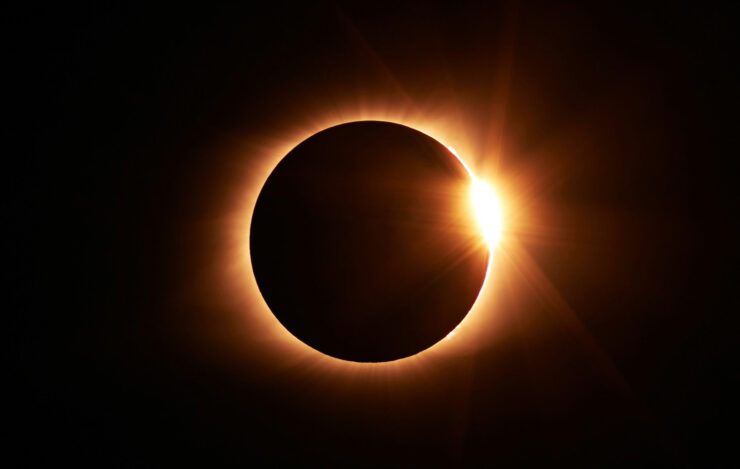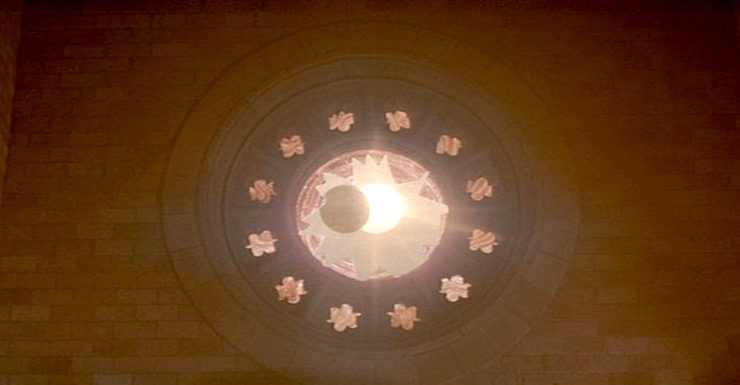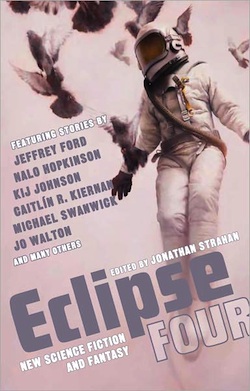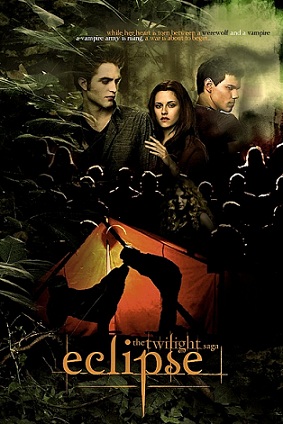Witnessing a total solar eclipse is often a once-in-a-lifetime event, so it’s fitting that even in fiction they get their due as legitimately monumental and awe-inspiring. The eclipses in these 10 SFF stories mean serious business—from alien invasions to world-ending prophecies, a lot can be at stake. But eclipses can also be useful—providing cover for a dramatic escape, or granting the power to break a wildly unfair curse…
Little Shop of Horrors
Here in the real world, humans have been able to predict eclipses with some accuracy for thousands of years, so it probably should have been a red flag to everyone when suddenly, and without warning, there was a total eclipse of the sun… Then again, who would’ve guessed that it was all just a distraction for an alien race to deposit a bunch of agents around the globe for the purpose of world domination? Seymour Krelborn learned this the hard way when looking for new strange and exotic plants for his little horticultural hobby. Mr. Chang sold him a plant he had never seen before, one that just showed up among the zinnias, right after the eclipse. A dollar ninety-five bought Seymour an unknown varietal that he christened the “Audrey II,” after his coworker and longtime crush.
And then the plant got a lot of attention in the flower shop where Seymour worked, and business started booming. And then Seymour discovered that the only way to keep the plant alive was by feeding it blood. And then the plant could talk suddenly? And then it didn’t seem like that big of a deal to murder Audrey’s abusive dentist boyfriend for the sake of keeping the plant alive… and it all sort of snowballed from there. There are two different endings to this tale, but even the happily-ever-after version leaves open the possibility that more Audrey IIs are on the rise. The point is, don’t feed the plants, and also maybe don’t buy unknown flora during solar eclipses.
A Connecticut Yankee in King Arthur’s Court by Mark Twain
When 19th century everyman Hank Morgan receives a blow to the head and wakes up just outside Camelot, he is assumed to be a threat because of his odd manner of dress and speech. Arthur sentences him to be burned at the stake on June 21st—and by a fantastic stroke of luck, Hank remembers that June 21, 528 C.E. was the date of a (fictional) solar eclipse, and so warns Arthur and Merlin that he’ll make the sun go out if they execute him. He’s a little off on the timing, but Hank manages to improvise and convince them he’s doing it with his superior magic. The court releases him, but he earns the undying hatred of Merlin, and spends the rest of the book trying to modernize Arthurian England, with mixed results.
Twain’s plot has inspired numerous homages and parodies—from Bugs Bunny and Darkwing Duck to MacGyver—but the eclipse itself may have been a reference to H. Rider Haggard’s adventure novel King Solomon’s Mines, in which British explorers take advantage of a lunar eclipse to turn the tide of a rebellion. Haggard in turn was likely inspired by accounts of Christopher Columbus “predicting” a lunar eclipse to intimidate the native people of Jamaica, but we prefer the out-of-his-depth time traveler version of this particular trope…
The White Gryphon by Mercedes Lackey and Larry Dixon
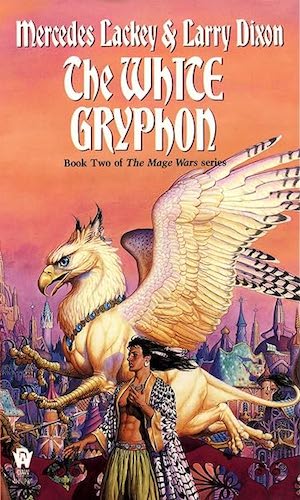
When the sun comes at midday, then change comes to the Haighlei…
Don’t like a particular law in the Haighlei Empire? Every 20 years, during the Eclipse Ceremony, you have the chance to change it. Assuming you’re an emperor, of course. And that the ramifications of various political marriages, foreign alliances, and advisory appointments haven’t altered Haighlei society so drastically as to render new social rules moot.
In the second installment of Mercedes Lackey and Larry Dixon’s Mage Wars trilogy, an embassy from White Gryphon attempts to negotiate an alliance with the people of Haighlei—conveniently during the timing of the Eclipse Ceremony. But when members of King Shalaman’s royal court begin turning up dead—members who opposed said treaty—protagonists Skandranon and Amberdrake come under suspicion. They have until the end of the Eclipse Ceremony to clear their names, and perhaps change the laws, before they will lose their chance for two decades.
Pitch Black
Sometimes the sun (or suns) is the only thing keeping you safe from untold aliens horrors. When the damaged Hunter-Gratzner lands on a seemingly barren world, the cryo-frozen passengers awake to find that the planet’s primary lifeforms are photosensitive and largely stick to caves and underground terrain—which is good because they’re a hungry bunch. This wouldn’t normally be a problem regardless because the planet has three suns that keep the world in perpetual daylight.
So you can see how an eclipse might not be exciting as prospects go.
The gore-fest that ensues is presided over by Riddick, a recently captured criminal who becomes the group’s only chance for survival. Aiding him in this venture are a set of modified eyes that make him highly sensitive to all light, meaning that his ability to see in darkness is much better than the average human. This doesn’t wind up being a whole lot of help to the group, who get picked off one at a time over the course of the film. In the end, it’s best to just get off of the planet before the eclipse is over. It’s not a good place to be when the sun’s not out.
Avatar: The Last Airbender
Also known as “The Day of Black Sun,” solar eclipses in the Avatar universe are notable for one reason: they severely limit the power of firebenders, who draw their energy from the sun. When Avatar Aang is looking for ways to defeat the Fire Nation and bring some balance back to the world, the eclipse offers an opportunity to get some much needed high ground.
While in the Spirit Library, Sokka stumbled upon a small footnote referencing a solar eclipse as “the darkest day in Fire Nation history.” The library also contained a planetary map room, allowing the group to determine the date of the next solar eclipse—conveniently only a few months away. The group planned an invasion of the Fire Nation’s capital, but unfortunately the Fire Lord was prepared; many of the invasion forces were captured, with only Aang and a few of his friends able to escape.
But it did help Prince Zuko’s emotional arc! During the invasion, Zuko was able to confront his father and announce his intentions to ally with the Avatar. So maybe eclipses are good for character development?
Heroes

Eclipses are a running theme in the superhero drama Heroes, linking characters and events across the globe. The first occurs in the series’ pilot, as a solar eclipse (somehow visible simultaneously in New York, Texas, Nevada, Japan, and California) coincides with several regular people discovering they have superpowers—perhaps most dramatically, teenager Claire survives a train wreck thanks to her rapid healing ability and then stares directly at the eclipse. (Please do not do this, superpowered or not.) At the end of season one, Hiro’s time-traveling ability lands him in 17th century Japan, where—in a slight nod to Twain’s Connecticut Yankee—a well-timed eclipse briefly distracts an army and allows Hiro to escape imminent danger. Later in the series, yet another solar eclipse saps everyone of their powers, lasting just long enough to ratchet up the dramatic tension (Claire gets shot when she’s no longer invulnerable!) without much in the way of lasting consequences (spoiler alert: she’s fine).
Ladyhawke
Ladyhawke is arguably the greatest of all ’80s fantasies. What is inarguable is that it features the best cinematic eclipse in movie history. Etienne Navarre is the knightiest knight who ever knighted, and his ladylove, Isabeau, is witty, beautiful, and a secret badass. Their love is pure and true, but unfortunately an eeee-villll bishop is also in love with Isabeau, and magically curses the couple. They are to remain “always together, yet eternally apart,” with Isabeau transforming into a hawk each morning at sunrise, and Navarre turning into a wolf as the sun sets each evening. To break the curse, they must appear as man and woman before the Bishop himself. As you might well imagine, trying to live life a half-day at a time while caring for either a hawk or a feral wolf is not fun, especially not in Quasi-Medieval Fairy Tale Europe, and neither Navarre nor Isabeau can think of a way to escape this dire situation.
Luckily for the star-crossed pair, they run into a thief called The Mouse and an alcoholic monk named Imperius who work out a solution: when is it neither fully day, nor fully night? Why, during a solar eclipse of course, and one just happens to be coming up! Now all they have to do is smuggle a wolf-man and hawk-woman across France and into the Bishop’s church before the eclipse blots out the sun’s rays…
The Wheel of Time by Robert Jordan
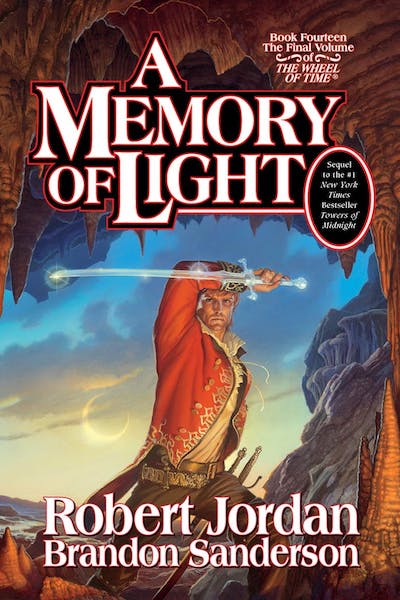
Twice dawns the day when his blood is shed.
Once for mourning, once for birth.
Red on black, the Dragon’s blood stains the rock of Shayol Ghul.
In the Pit of Doom shall his blood free men from the Shadow.
Wow! That’s one hell of a mission statement to give your epic fantasy hero. In the second book of Robert Jordan’s Wheel of Time, Rand al’Thor is still very much coming to terms with being the Dragon Reborn, the prophesied savior of the world, when he asks about prophecies that detail, you know, Next Steps. One of the prophecies includes this demoralizing stanza, letting Rand know that at some point he’ll probably find himself in the worst place in the world, exploding like a depressurized intestine.
Naturally, readers parsed this endgame-esque prophecy for clues, quickly determining that “twice dawns the day” probably indicated a solar eclipse. The imagery was apt for the series, which concerns itself with the decisive struggle between humanity (the Light) and an unequivocally evil metaphysical force (the Shadow) determined to end time itself. If a literal eclipse occurred at a key moment, it would have a symbolic effect upon the forces of the Light; a window where the Shadow held sway over the Light. The primal fear that would instill within the Lightside combatants could prove just enough to turn the tide of the conflict towards the Shadow. The “twice dawns the day” line is so important to the aesthetic of Jordan’s epic, in fact, that the final book in the series is titled A Memory of Light, with the cover itself featuring the very moment the prophecy proves true.
So it’s a bit of a puzzler that the eclipse just turns out to be a… cloudy day?
Above them, dark clouds spun, the peak of Shayol Ghul their axis. Darkness assaulted the sun until it was nearly gone, entirely covered, in total oblivion.
In the sentence following that, both the forces of the Light and the Shadow pause. Then the clouds pass in the sentence after that, and everyone resumes fighting as before. No eclipse, no ominous pauses, no sinking feeling from our favorite super-characters that they’re fighting a force of nature itself and none of this may be enough. A bit of a cosmic shrug, all in all.
Dragonslayer
Dragonslayer is one of the best fantasy movies of the fantasy-rich 1980s. While its use of an eclipse isn’t quite as iconic as that of Ladyhawke, it still finds an interesting way to use it. Sorcerer’s apprentice Galen embarks on a quest to kill the dragon Vermithrax Pejorative, in order to end the barbaric practice of maiden sacrifice in Urland. Alongside this excellently-done-but-rather-standard-faux-medieval-quest-story, the movie also gives us a more complicated tale: magic is dying out (and gradually taking dragons with it) because more and more people are converting to a new religion called Christianity. In the end, the reflection of the solar eclipse in a lake creates a “lake of fire”— fulfilling a prophecy Galen’s master made. While the young man ventures into Vermithraxis’ lair, and is able to defeat the dragon during the eclipse, most of the villagers take the cosmic event and a magical storm to mean that the Christian God has intervened and rescued them from a monster. Anyone that hadn’t already converted now embraces the faith, and Galen is left to find a new life in a world that thinks it doesn’t need sorcerers.
Nightfall by Isaac Asimov and Robert Silverberg
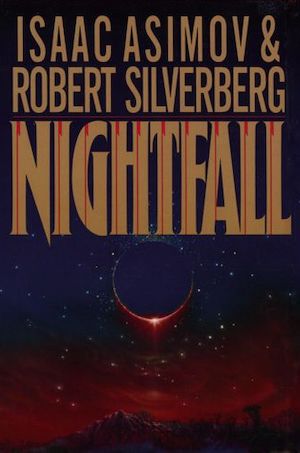
When your planet is surrounded by six suns, darkness itself is akin to the bogeyman: this creeping threat that you’ve never experienced, and never want to experience. How can you imagine such vulnerability, in a darkness that can neither be perceived nor fathomed, without going mad? If you’re the inhabitants of Kalgash in Asimov’s short story-turned-novel Nightfall, you sleep with night lights; you make darkness the big jump scare in theme park rides; and you fear the very real and very alien eclipse foretold to occur every 2,049 years.
Historical texts warn that every two millennia, the total eclipse has caused the downfall of civilization—surely when the inhabitants of Kalgash were plunged into darkness, they simply went insane? Not so, as the current society discovers: The eclipse not only blots out the suns, but it also reveals the stars. The stars that the Kalgash people had no idea existed. The hundreds of thousands of stars that force them to confront their own insignificance in a universe they used to believe they were at the center of.
It’s enough to send anyone spinning out of orbit. But hey, they have 2,049 years to rebuild…
These are just a few of the many solar eclipses that appear in fiction—and we didn’t even cover the many lunar eclipses that also make for dramatic plot points (we see you, Hellboy fans). Add your own favorite SFF eclipses in the comments!
An earlier version of this article was published in August 2017.










